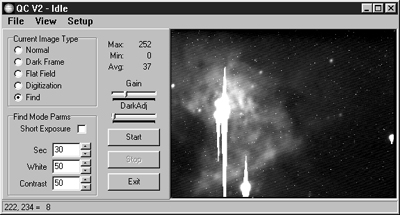
Greyscale quickcam Cooling Project - 1/14/00
Discussed here are:
Page 1 - Conversion of greyscale quickcam
Page 2 - First light under frigid temperatures
Page 3 - Herring bone interference problem?
Page 4 - Long Exposure Results
Page 5 - Plans for cooling with peltier device and fan
UPDATE 2/3/00: Cooled Greyscale Quickam Completed - Click here for details
Any advice or comments can be sent to me at: ghonis@epix.net
CONVERSION OF GREYSCALE QUICKCAM
After converting the Quickcam VC for astro imaging, and being happy with the ease of its use and good results on the Moon and planets, I decided to try conversion of a greyscale quickcam for longer exposures. Dave Allmon's software program QCV2 now allows up to five minute exposures to be taken (Thanks Dave). I bought two greyscale quickcams for $24. I adapted one quickcam using the same method as the VC that I converted. Many sites are on the web showing ways for doing this. Here's what I did:
1. Opened plastic shell
2. Unscrewed optics from circuit board.
3. Drilled 1.5 inch hole in shell
4. Glued T-thread from a camera T-ring adapter over the hole
For the greyscale quickcam I disconnected the yellow wire to disable antiblooming of the CCD. Directions for doing this are on Dave Allmon's site at: http://ns.par1.net/~dallmon/html/abgmod.html
Here is a screen shot of a raw image of the Trapezium taken with the anti-blooming disabled using the QCV2 software:

Yep, looks like the anti-blooming disable fix works! Bright stars are bleeding and they're suppose to.
In my working unit I will add a switch to the yellow wire to enable and disable anti-blooming. I hope that the herring bone pattern I am seeing isn't because this wire has been disconnected (discussed later).